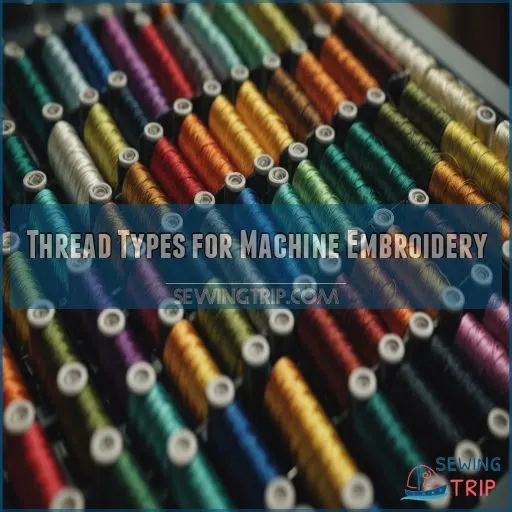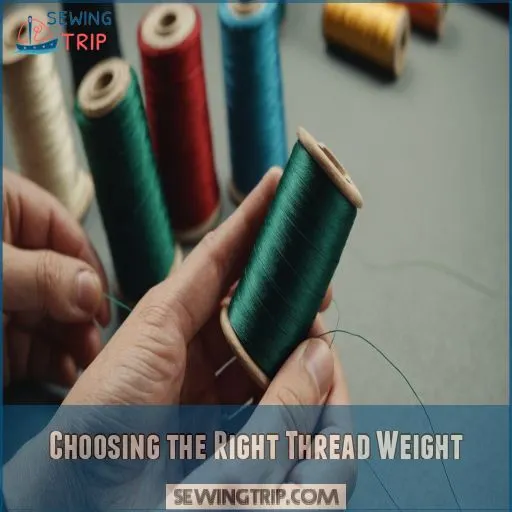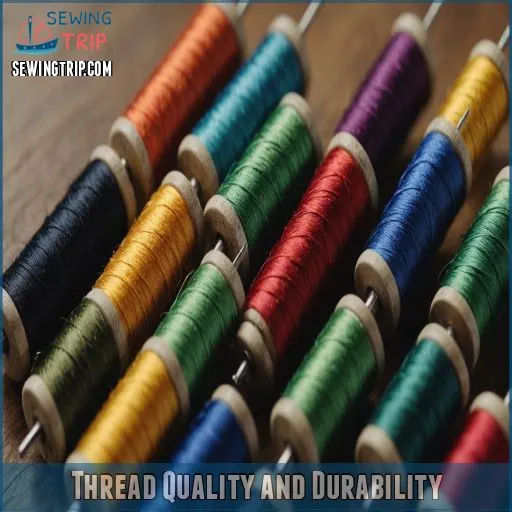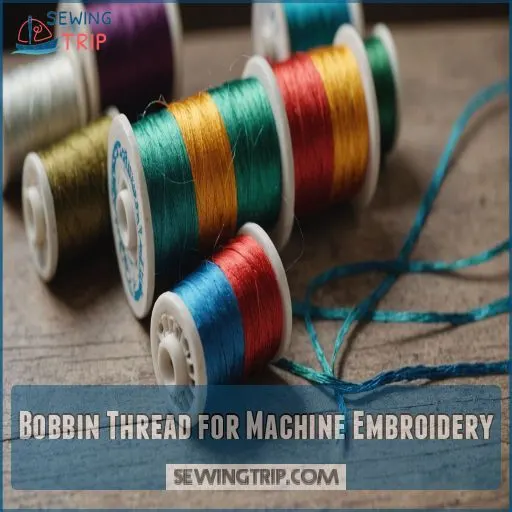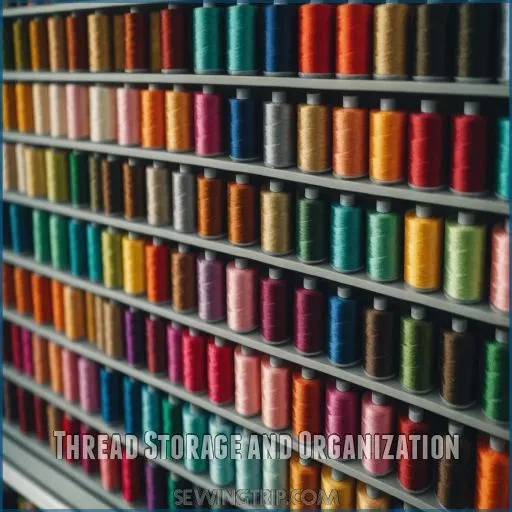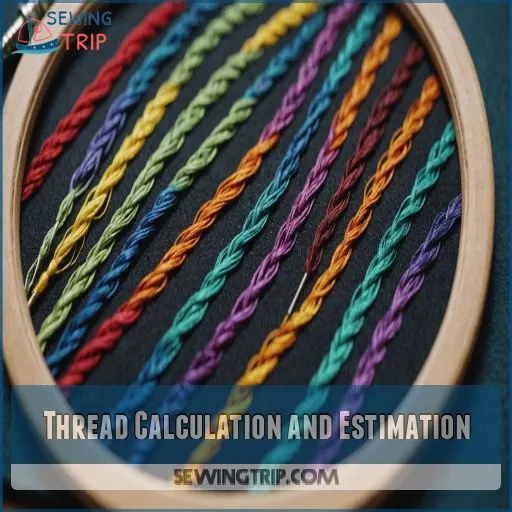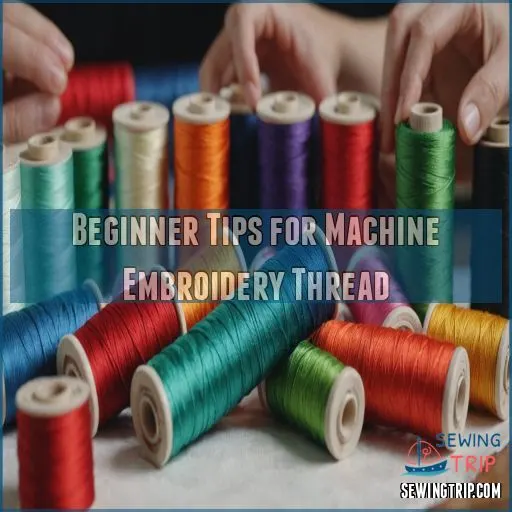This site is supported by our readers. We may earn a commission, at no cost to you, if you purchase through links.
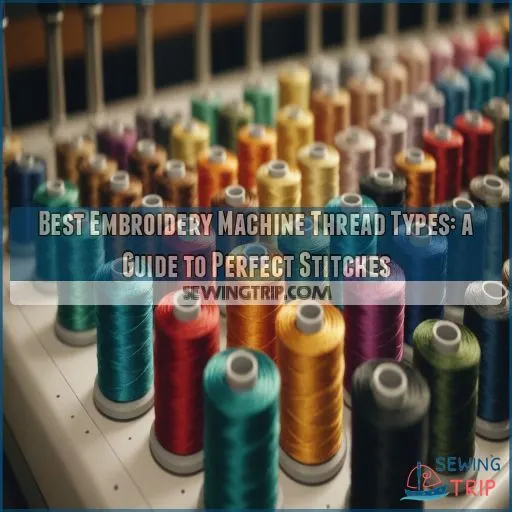 When it comes to the best embroidery machine thread types, you’ve got options! Rayon’s your go-to for vibrant, shiny designs, while polyester’s tough-as-nails for high-wear items.
When it comes to the best embroidery machine thread types, you’ve got options! Rayon’s your go-to for vibrant, shiny designs, while polyester’s tough-as-nails for high-wear items.
Cotton gives that cozy, vintage vibe, and silk? It’s the Cadillac of threads, perfect for luxe projects.
Don’t forget metallic threads for some serious sparkle – just be prepared to slow your machine down a tad.
Quality matters, folks; cheap thread is like using ketchup instead of tomato sauce in your grandma’s secret pasta recipe.
Stick with trusted brands like Madeira or Isacord, and you’ll be stitching up a storm in no time. But wait, there’s more to thread than meets the eye…
Table Of Contents
Key Takeaways
- You’ve got options galore when it comes to thread types, but remember: rayon is your go-to for vibrant shine, polyester is your tough guy for high-wear items, cotton is perfect for that cozy vintage vibe, and silk? It’s the Cadillac of threads for your luxe projects. Choose wisely, and you’ll be stitching up a storm in no time!
- Don’t let thread weight tie you up in knots! Think of it like pasta – each weight has its perfect sauce (or in this case, project). The trusty 40 wt is your all-purpose workhorse, while 30 wt gives you bold lines, and 50 wt nails those fine details. Match your thread weight to your project, and you’ll be cooking up embroidery masterpieces faster than you can say "al dente"!
- Quality matters, folks! Skimping on thread is like using ketchup instead of tomato sauce in grandma’s secret pasta recipe – it just won’t cut it. Invest in high-quality threads from trusted brands, and you’ll save yourself the headache of breakages, fraying, and pilling. Your embroidery machine – and your sanity – will thank you!
- Don’t forget about your trusty sidekick – the bobbin thread! Whether you go for polyester or cotton, using a dedicated bobbin thread (often in white) will keep your stitches smooth and your backside clean. It’s like having a secret agent working behind the scenes to make your embroidery look flawless from every angle!
Thread Types for Machine Embroidery
Embroidery threads come in a dazzling variety, each having its quirks and charms—much like your favorite quirky cousin at family gatherings.
By understanding the unique characteristics of rayon, polyester, cotton, silk, and other specialized threads, you’ll transform your projects into masterpieces, one stitch at a time.
Rayon Embroidery Thread: Advantages and Disadvantages
Rayon embroidery thread is your colorful dance partner in the embroidery world. Its vibrant sheen brings designs to life, though it’s not always the sturdiest.
- Shiny Sheen: Adds a lustrous finish to your creations.
- Smooth Performance: Glides effortlessly in high-speed machines.
- Color Vibrancy: Offers clear, bright hues.
- Sensitive to Bleach: Needs careful handling to prevent fading.
Enjoy its artistic flair while minding the bleaching blues!
Polyester Embroidery Thread: Strong and Durable
If you’ve ever tussled with embroidery, you’ll know polyester thread is your trusty sidekick.
It’s brilliantly strong and durable, often outshining rivals with vibrant, lasting colors.
You’ll find peace of mind knowing it resists bleach , tackles tight thread tension like a champ, and rarely breaks.
Plus, keep your embroidery machine spotless for smooth stitching.
Cotton Embroidery Thread: Natural Look and Feel
After exploring polyester’s durability, let’s switch gears to cotton embroidery thread, offering a natural look and feel.
Enjoy cotton’s benefits with:
- Soft, vintage appeal: Ideal for projects needing a handcrafted touch.
- Less sheen: If subtlety is your style, cotton delivers.
- Embrace lint: It’s natural fiber charm, though lowering machine speed can help.
Silk Embroidery Thread: Luxurious and Versatile
Silk embroidery thread is the crème de la crème of machine embroidery.
Its luxurious sheen and soft, supple feel elevate any project to new heights.
Whether you’re stitching delicate florals or bold designs, silk thread’s strength and smoothness guarantee flawless results.
Treat yourself to this opulent fiber – your embroidery will thank you!
Metallic Embroidery Thread: Shiny and Eye-Catching
Metallic embroidery thread adds sparkle to your projects, like a shiny cherry on top of an intricate sundae.
To avoid frustration, pick metallic thread brands carefully—opt for high-quality options like Kreinik or Superior Metallics.
Slow down your embroidery machine, reduce tension, and use a large needle for the best results.
Let your creativity shine!
Glow-in-the-Dark and UV Color-Changing Threads
Imagine your project glowing with creativity!
Glow-in-the-dark and UV color-changing embroidery threads add magic to your designs. Easy to charge with light, they offer endless possibilities for vibrant color combinations and creative uses.
Be mindful of thread safety and UV exposure, ensuring your masterpiece shines bright.
Embrace these threads, and expand your embroidery machine’s potential with endless possibilities!
Choosing the Right Thread Weight
Choosing the right thread weight can feel like picking the right pasta for a sauce; each has its unique role.
Don’t worry, though—this guide will help you navigate the numbers so your stitches are as silky as your grandma’s lasagna.
What is Thread Weight and How to Measure It
Choosing embroidery thread involves understanding thread weight, the unsung hero of stitch quality.
Measured by length needed to weigh one kilogram, smaller numbers mean thicker threads. Imagine heavier threads as sumo wrestlers—they’re powerful but need space!
Use a thread weight chart for easy comparison and conversions . Testing different weights impacts your project’s final touch and stitch definition.
Common Thread Weights for Machine Embroidery
Understanding thread weights can be like looking at a thread weight chart—you’ll quickly see different options.
- 30 wt: Perfect for bold, thicker embroidery lines.
- 40 wt: Generally used for balanced stitch quality.
- 50 wt: Ideal for finer details.
Remember, needle size compatibility helps prevent pesky thread breaks!.
40 Wt Thread: the Most Popular Choice
The trusty 40 wt thread is the embroidery workhorse – it’s the Goldilocks of thread weights, not too thick or thin.
This versatile thread excels at machine quilting, appliqué, and embroidery, delivering a just-right balance of stitch definition and texture.
With 270 vibrant colors to choose from, 40 wt thread is the ideal all-purpose companion for your embroidery machine.
Adjusting Needle Size for Different Thread Weights
Adjusting needle size for different thread weights is like tuning a finely crafted instrument, considering the right machine embroidery needles
.
To achieve perfect embroidery, match your needle size with the thread and fabric:
- 40 wt. thread: Use a #90/14 needle.
- 30 wt. thread: Opt for a #100/16 needle.
- Thicker threads: Go larger.
- Lighter fabrics: Choose finer needles.
Happy stitching!
Thread Quality and Durability
Thread quality can make or break your embroidery project, so it’s worth giving it a little TLC.
Imagine stitching along smoothly with durable thread, only to find the inferior kind fraying faster than your patience when caught in traffic!
How to Check for Quality Embroidery Thread
To spot good-quality embroidery thread, wrap it around your fingers and feel for smoothness.
Strong threads won’t snap with a gentle tug. Check for consistent sheen and vibrant colors—signs of colorfast threads that resist fading.
Trust me, a reliable thread will glide through your embroidery needle like a dream, free of tangles and frustration (Source).
Factors Affecting Thread Quality: Material, Construction, and Finish
Checking thread quality involves more than a quick glance.
Consider fiber types for durability and vibrant dye quality for lasting color.
A strong thread twist can prevent unraveling disasters.
Finish treatments like bonding add strength and longevity to your embroidery machine thread with high-quality threads like Variegated Embroidery Thread Kits
.
Explore this maze, and find threads that make your stitches sing with reliability and beauty.
Signs of Poor-Quality Thread: Breaking, Fraying, and Pilling
Spotting poor-quality embroidery thread? It’s like noticing a bad coffee day—nobody wants it.
You’ll see thread breakage, fraying, or even pilling—tiny fabric balls that scream frustration .
These issues stem from the thread’s construction or finishing flaws.
Invest in robust threads to keep your embroidery machine humming like a well-oiled cat purring in the sun.
Benefits of High-Quality Thread: Smooth Stitching and Long-Lasting Results
Imagine stitching your next masterpiece without a hitch—smooth stitching and thread durability are your secret weapons.
High-quality embroidery thread makes sure your design stands the test of time, enhancing your project’s lifespan by ensuring proper thread tension
.
With superior embroidery thread, fraying and breaking are yesterday’s news.
Invest in the best, and let your creativity shine with exceptional stitch quality and embroidery longevity.
Bobbin Thread for Machine Embroidery
For machine embroidery, picking the right bobbin thread is just as important as choosing the perfect top thread.
Whether you go for a trusty polyester or a soft cotton, using a dedicated bobbin thread will make sure your stitches are smooth and your backside is clean and tidy.
Choosing the Right Bobbin Thread: Polyester or Cotton
Choosing the right bobbin thread can make your embroidery shine. Polyester thread offers durability and longevity, while cotton delivers a natural touch.
Consider these when selecting:
- Thread Weight: 60 wt is common.
- Tension: Keep it balanced.
- Color: Often white or neutral.
- Brands: Aurifil, Superior.
- Longevity: Polyester outlasts cotton with high-use projects.
How to Use White Bobbin Thread for Invisible Stitches
You’ve got this! Using white bobbin thread for invisible stitches starts with adjusting bobbin thread tension and stitch density.
Select a compatible fabric and embroidery design to make sure seamless stitching with traditional embroidery basics
.
A 50 wt cotton bobbin thread works wonders, creating those almost-magical invisible stitch techniques. Remember, a touch of practice and humor—it’s like threading a needle, with love and patience!
Benefits of Using a Dedicated Bobbin Thread
Using a dedicated bobbin thread can greatly enhance your embroidery experience.
It provides smooth stitching, consistent tension, and reduces thread breakage.
This results in improved durability and an enhanced appearance of your embroidery.
Investing in a good quality bobbin thread is essential for achieving professional-looking results.
Thread Storage and Organization
Keeping your embroidery threads organized can be a creative challenge.
You’ll find that using thread stands, spool holders, and repurposed containers tidies up your workspace.
but also inspires your next stitching adventure.
Thread Stands and Spool Holders for Easy Access
Ease your sewing experience with thread stands—a must-have for smooth stitching, especially when working with delicate specialty threads like silk or metallics.
- Opt for weighted stands to prevent tipping, as embroidery threads can be prone to tangling or fraying if not stored properly.
- Multi-spool stands simplify color switching.
- Use thread guides to avoid tension issues.
- Try repurposing items around your house for DIY solutions!
Tips for Storing and Organizing Embroidery Threads
When organizing your embroidery threads, a little planning goes a long way. Consider winding them on plastic bobbins and labeling them for ease of use. Store these in transparent containers or binders for quick access.
It helps you see whether you’ve stockpiled too many purples or if you’re surprisingly short on blues.
| Option | Pros |
|---|---|
| Plastic Bobbins | Prevent tangling |
| Zip-Lock Baggies | Portable and compact |
| Binder with Sleeves | Organized and neat |
| Hanging System | Space-saving alternative |
| Thread Cards | Easy color selection |
Creative Ways to Repurpose Thread Storage Containers
Repurposing thread storage containers can be a fun way to breathe new life into your crafting space.
You’ll love these creative ideas:
- Turn pasta drying racks into thread organizers
- Create a thread-lined drawer for easy access
- Upcycle vintage boxes for a charming display
- Use clear jars to showcase colorful spools
Not only will you save money, but you’ll also add a personal touch to your sewing area. Who knew those old containers could become such eye-catching craft storage solutions?
Thread Calculation and Estimation
Figuring out how much thread you need for your embroidery projects can seem like a big task, but it’s a useful skill to learn.
With a few handy tips and tricks up your sleeve, you’ll be estimating thread needs like a pro in no time.
Saving both money and hassle on your stitching adventures.
How to Estimate Thread Usage for Your Projects
Estimating thread usage for your embroidery projects can feel like a guessing game, but it doesn’t have to be.
You’ll want to think about key factors like thread length, stitch density, design size, and project complexity.
For a quick reference, remember that a lap-size quilt with light quilting typically uses about 200 yards of top thread.
As you gain experience, you’ll develop a better eye for thread requirements and be able to tackle more complex projects, including those with varying degrees of project complexity.
Tips for Accurate Thread Calculation and Estimation
Thread calculation can be a tangled mess, but it doesn’t have to tie you in knots! Accurate estimation means you’ll never run out mid-project.
- Calculate thread length per stitch based on fabric thickness
- Factor in design complexity and stitch density
- Account for thread waste during setup and finishing
- Use a thread gauge to measure remaining spool length
Remember, practice makes perfect – soon you’ll be eyeballing thread needs like a pro!
Beginner Tips for Machine Embroidery Thread
As a beginner in machine embroidery, picking the right thread is really important for getting amazing results, especially when it comes to mastering embroidery machine basicsMastering Your Embroidery Machine
.
Let’s explore some essential tips to help you understand embroidery threads, making sure your projects get off to a good start and your stitches look great.
Avoiding Cheap Thread: Why It’s Not Worth the Risk
A penny-wise, pound-foolish approach to embroidery thread can unravel your projects faster than you can say "bobbin."
While it’s tempting to pinch pennies, cheap threads often lead to a tangled web of frustrations. They’re prone to breakages, knots, and dullness .
Even worse, they can damage your machine and leave your creations looking less than stellar. Don’t let false economy stitch you up!
Investing in High-Quality Thread: Benefits and Recommendations
Every seasoned embroiderer knows investing in high-quality thread pays dividends.
You’ll save time and frustration by avoiding breakages and poor stitching . Brands like Madeira, Isacord, and Sulky offer excellent quality without breaking the bank.
Remember, your thread is the backbone of your project – skimp here, and you might as well embroider with dental floss!
Proper storage in thread stands keeps your investment tangle-free and ready for your next masterpiece (Source).
Frequently Asked Questions (FAQs)
What is the best embroidery thread for machine embroidery?
Ah, the eternal quest for the Holy Grail of embroidery threads!
You’d think it’s simpler than finding a needle in a haystack.
For machine embroidery, polyester’s your best bet.
It’s strong, shiny, and won’t break the bank.
What are the different types of machine embroidery threads?
You’ll find several types of machine embroidery threads to suit your needs.
The main players are rayon, polyester, and cotton, each with unique qualities.
For specialty work, don’t forget about silk and metallic threads.
How to choose embroidery thread?
Like choosing the perfect paintbrush, selecting embroidery thread is an art.
Consider your project’s needs – fabric type, desired effect, and durability.
Experiment with various threads, from cotton to silk, to find what works best for you.
Trust your creative instincts!
What are embroidery threads?
Embroidery threads are your vibrant palette for stitching magic.
They come in various materials like cotton, silk, and rayon, each with unique properties.
You’ll find different weights and finishes to bring your designs to life.
What is the difference between regular and machine embroidery thread?
Did you know that 40-weight is the standard for machine embroidery thread?
Machine embroidery thread’s got a special lubricant for high-speed stitching, while regular thread’s built for strength.
You’ll find machine thread’s thinner and shinier, perfect for those fancy designs, as it has a specific quality that differs from regular thread, making high-speed stitching possible.
What are the different weights of machine embroidery thread?
You’ll encounter three main thread weights in machine embroidery: 40-weight for general use, 60-weight for fine details, and 30-weight for filling large areas.
There’s also 12-weight for decorative edging and bold designs.
How do embroidery thread colors affect design visibility?
Like an artist’s palette, thread colors paint your design’s visibility.
You’ll see bolder effects with contrasting hues, while subtle shades blend seamlessly.
Reflective threads can even add surprise sparkle, lighting up your creations in unexpected ways .
Can I use metallic thread for all embroidery projects?
Metallic thread isn’t suitable for every project.
While it adds glamour, it’s delicate and can be tricky to work with.
You’ll need to adjust your machine settings and spool positioning for best results.
Are there eco-friendly options for embroidery thread?
Imagine a lush forest growing from your embroidery hoop.
Eco-friendly embroidery threads are flourishing. From AMANN’s 100% recycled polyester to A&E’s ECO100 line made from recycled materials , you’ve got green options galore.
Whats the best thread for embroidering on stretchy fabrics?
For stretchy fabrics, you’ll want a thread that’s both strong and flexible.
Use polyester or nylon threads, as they’ve got the stretch to move with the fabric.
Pair ’em with a stabilizer to keep your stitches smooth and pucker-free.
How often should I replace my machines embroidery needle?
Time flies when you’re stitching!
You should replace your embroidery needle every 8-24 hours of use.
For larger projects, aim to change it after 27,000 stitches or when you notice decreased performance (Source).
Conclusion
Ready to take your embroidery to the next level?
The secret’s in the thread! By now, you’re armed with the knowledge to choose the best embroidery machine thread types for your projects.
Remember, quality matters – don’t skimp on your threads! Whether you’re stitching with vibrant rayon, durable polyester, or luxurious silk, the right thread can make or break your design.
So go ahead, experiment with different types, and watch your creations come to life. Happy stitching, and may your bobbin always be full!

